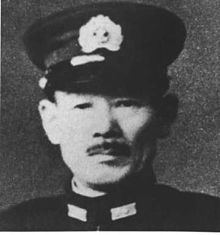Years of service 1911-1943 | Died 1949, Japan Name Hiroaki Abe | |
 | ||
Commands held Jintsu, Fuso8th Cruiser Division, Carrier Fleet Support Force, 11th Battleship Division Battles/wars World War II* Attack on Pearl Harbor* Battle of Wake Island* Battle of Midway* Battle of the Eastern Solomons* Battle of the Santa Cruz Islands* Naval Battle of Guadalcanal Similar People Nobutake Kondo, Daniel J Callaghan, Raizo Tanaka, Norman Scott, William Halsey - Jr | ||
Hiroaki Abe (阿部 弘毅, Abe Hiroaki, 15 March 1889 – 6 February 1949) was an admiral in the Imperial Japanese Navy during World War II.
Contents
Early career
Abe was born in Yonezawa city in Yamagata prefecture in northern Japan. He graduated from the 39th class of the Imperial Japanese Naval Academy in 1911, with a ranking of 26th out of a class of 148 cadets. As a midshipman, he served on the cruiser Soya and battleship Mikasa. After his promotion to ensign on 1 December 1912, he was assigned to the cruisers Nisshin and Chikuma, and the battleship Kongō.
After attending torpedo school and naval artillery school, he was promoted to sub-lieutenant and served on the destroyer Akebono, followed by the cruiser Chitose during World War I. However, it does not appear that Abe experienced combat during his tour of duty.
After the end of the war, he served in mostly staff positions until he was given his first command on 20 July 1922; the destroyer Ushio. He then commanded the destroyer Hatsuyuki, and was promoted to lieutenant commander the following year on 1 December 1923. He was captain of the destroyer Kaki for one year in 1925.
Abe returned to the Naval Staff College in 1926. He was promoted to commander on 10 December 1928, and captain on 1 December 1932. In 1936, he assumed command of the cruiser Jintsu, and a year later, that of the battleship Fusō.
Pacific War
On 15 November 1938, Abe was promoted to the rank of rear admiral. He was thus in command of Cruiser Division 8 (CruDiv8) during the attack on Pearl Harbor, and the subsequent Battle of Wake Island.
During the Guadalcanal campaign, as commander of Combat Division 11 (BatDiv 3 and CruDiv 8), he led his ships as the vanguard group at the Battle of the Eastern Solomons from 23–25 August 1942 and the Battle of the Santa Cruz Islands from 26–28 October. He was promoted to vice admiral on 1 November.
However, during the Naval Battle of Guadalcanal on 12–13 November, when assigned to bombard Henderson Field on Guadalcanal, he broke off his attack after encountering U.S. Navy Rear Admiral Daniel Callaghan's Task Group 67.4 (TG 67.4). Abe lost his flagship, the battleship Hiei, which he ordered scuttled after it had been seriously damaged, as well as two destroyers. Abe himself was injured - and his Chief-of-Staff (Captain Masakane Suzuki) was killed - by machine gunfire from USS Laffey (DD-459), a destroyer which he in turn sank afterwards. His failure to aggressively push through his attack against what appeared to be an inferior enemy force created tremendous controversy, and he was relieved of his command by Admiral Isoroku Yamamoto.
Abe was forced to resign from the Imperial Japanese Navy soon afterward in March 1943. He died in 1949.
His younger brother, Toshio Abe, was also a career navy officer, and was captain of the aircraft carrier Shinano. Toshio went down with Shinano, when she was torpedoed and sunk by USS Archerfish (SS-311) while performing trials.
